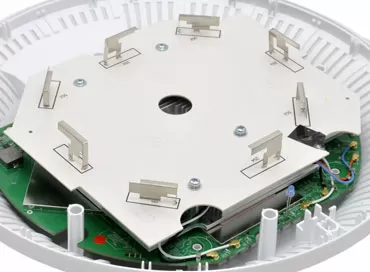Omada SDN Ecosystem: achieve more with less investment
The business style of today's businesses is becoming increasingly dynamic. For operational activities, companies have to rely on a variety of digital services, and devices that are connected to a local network to perform daily tasks are becoming more and more numerous. Local networks are becoming larger, and the demand for convenient and reliable solutions is increasing – while budgets for IT infrastructure often remain the same.
Given the current realities, many companies see the main priority of maintaining a stable commercial activity, and the issues of implementing new IT practices are resolved in the future. Thus, the question arises: how can we create and manage large-scale and complex networks today and at the same time save employees ' time, as well as investments in infrastructure?
|
The transition to Wi-Fi 6 is a natural step for businesses seeking to improve wireless network performance in an era of growing Internet traffic and the quality of transmitted content. If a company's or facility's network relies heavily on wireless infrastructure, then adding Wi-Fi 6 features can provide significant resilience and efficiency to such a network with a margin of years. Building a Wi-Fi 6 network on TP-Link equipment will allow you to implement larger projects with less investment, and the client will have access to a full set of Enterprise functions at the start, which does not require additional costs. The access points of the AX class themselves will be relevant for the entire life of this wireless network standard. |
Centralized management of network infrastructure, standardization of operational activities, improving the security of information resources, reducing costs-often these tasks are solved by implementing the SDN network or, in other words, by creating a network managed at the software level.
What is SDN?
The SDN class network has software at its core that acts as a controller that allows you to automatically deploy network services and distribute settings between devices. Such a network is designed to solve problems where the deployment of a traditional network is problematic, as well as difficult to maintain or scale. SDN network automation is based on the separation of data exchange through centralized management and policy assignment for devices. With SDN technology, the Omada solution enables the automatic placement of network services and the automatic distribution of data between gateways, switches, and access points.
The Omada SDN controller integrates security gateways, switches, and Wi-Fi devices into a single comprehensive software-configurable network that is designed to work efficiently in demanding environments with high volumes of customers and traffic, such as on college campuses, hotels, shopping malls, conference halls, stadiums, train stations, and airports. The Omada SDN controller is the command center and control platform at the center of the Omada network. With a single platform, network administrators will be able to configure and manage all devices from the Omada line to meet the needs of routing, switching, and wireless network access.
Setting up by location (objects)
The process of issuing settings by the controller is based on locations that are logically separated by network objects. Location is the largest unit in network management in the Omada SDN plane. For example, devices belonging to a specific department of the company require the same settings. System administrators will be able to create a special location for this department and then issue settings to the corresponding wired and wireless networks. What previously took days can now be done in a few minutes.
All Omada devices in the same location (for example, all managed switches) will have the same settings, except for the IP address and network name. The Omada SDN controller will allow you to simultaneously configure features such as VLAN and PoE schedule for different switches, and you will be able to simultaneously configure features such as SSID, WLAN schedule, and traffic rate for multiple access points. The SSID that you provide to a single access point will be scaled to all access points in that location.
Cloud-based access management
With cloud access, the Omada software and hardware controller is able to centrally manage the entire network – from anywhere with internet access, without additional license fees. In practice, this is implemented as follows: you install many Omada devices on an object, and then implement a software or hardware controller for group management of devices. While away from the facility, you can monitor and manage your wireless network from a web browser or from a mobile app on your smartphone or tablet.
Omada SDN Features and Functions
Centralized management
Different network utilities with different interfaces can create difficulties in configuring and managing the network infrastructure, increasing the likelihood of further errors. Using different services is time-consuming and can significantly increase the time required to make simple changes or perform troubleshooting tasks. Configuring and managing gateways, switches, and Wi-Fi devices from a single platform successfully eliminates repetitive manual device management tasks and the potential for errors.
Easy maintenance
The configuration of many functions of the Omada SDN controller is based on profiles that include VLAN settings, RADIUS server authentication, and PoE schedules. The profile records the parameters to be set. Changes to the profile can be made at any time, making the network as responsive as possible to the changing needs of the IT service and business in just a couple of clicks.
Improved security
In addition to directly creating the network, the Omada SDN controller provides multiple access, traffic, and application control policies to implement complex business tasks. VPN, configurable authentication portal, 802.11 x, and other security features will ensure that your network is protected in the fastest and easiest way.
In addition to the above, it is necessary to mention three key technologies that allow Omada SDN to perform fast and convenient management.
First, it is an artificial intelligence-based technology that provides high-performance wireless connectivity, allowing you to change the channel settings and broadcast power of neighboring access points on the same network. It also analyzes potential problems in the network, notifies users, and suggests solutions. In this case, you will no longer have to worry about interference in the Wi-Fi network between different points, and in the critical event of a network failure, you will be protected.
The second important technology is Zero-touch provisioning, or automatic configuration of network parameters. It involves remote configuration of network equipment on the site. In other words, once you have used the resources to install the equipment, you will not have to re-send specialists to the facility to configure it. Configuration does not require in-depth technical knowledge and can be done remotely by sending a configuration file.
The third technology of the Omada solution is the ability to deploy an efficient Wi-Fi network in an environment with a high number of clients. With high-end chipsets, dedicated antennas, automatic channel selection, and transmitter power settings, Omada Wi-Fi 5 and Wi-Fi 6 access points deliver high performance in a busy user environment.
Alexey Usachev, Head of the Project Department TP-Link
29/03.2021

 Alexey Usachev, project Manager at TP-Link:
Alexey Usachev, project Manager at TP-Link:










